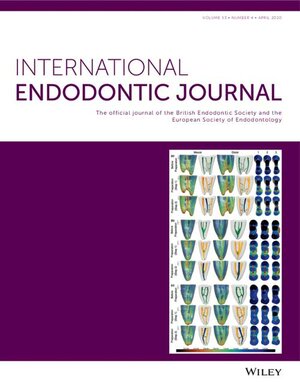The outcome of full and deep pulpotomy in teeth with extremely deep carious lesion and symptomatic irreversible pulpitis: A non-inferiority randomized controlled trial
Abstract
Aim
To compare the outcome of full and deep pulpotomy performed in mature permanent teeth with extremely deep carious lesion and symptomatic irreversible pulpitis.
Methodology
This parallel-group, double-blind, non-inferiority randomized controlled trial was conducted after ethical clearance. Patients with mature permanent teeth with extremely deep carious lesion and diagnosis of symptomatic irreversible pulpitis were recruited. Teeth were randomly allocated to two study groups, i.e. Group I: full pulpotomy (excision of pulp tissue up to the level of root canal orifices) and Group II: deep pulpotomy (excision of radicular pulp tissue 2–3 mm apical to root canal orifices). Haemostasis was achieved using cotton pellet moistened with 2.5% NaOCl for up to 10 min. Mineral trioxide aggregate was used as a pulp capping agent and teeth were restored in the same visit with resin composite. Outcome assessment was performed at 12-month follow-up based on clinical and radiographic evaluation. The success rate was determined by intention-to-treat (ITT) and per-protocol (PP) analysis. Two sample t-tests were used to compare the time taken to achieve haemostasis and determine its association with treatment outcome.
Results
A total of sixty teeth received treatment in both study groups. The bleeding time was significantly more in Group I (6.13 ± 1.59 min) compared to group II (5.23 ± 1.22 min) (p < .0171). The recall rate was 86.6% at study end point when fifty-two teeth were analysed at 12-month follow up. The success rate was 88.46% and 92.30% for per protocol analysis and 76.67 and 80% for ITT analysis for Group I and Group II, respectively, without any statistically significant difference (p = .610). The absolute risk difference between each treatment was within the 10% non-inferiority limit. There was no statistically significant association between time taken to achieve haemostasis and treatment outcome in both study groups.
Conclusions
There was no significant difference between full and deep pulpotomy techniques, with respect to achievement of haemostasis and treatment outcome for management of teeth with extremely deep caries and irreversible pulpitis.

 求助内容:
求助内容: 应助结果提醒方式:
应助结果提醒方式:


